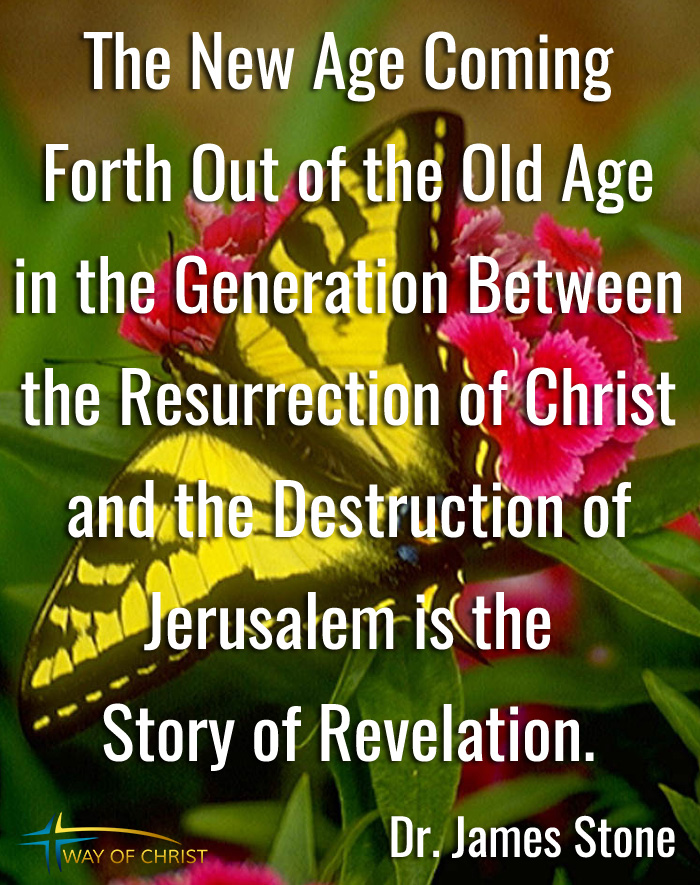Revelation, as recorded by John, is the disclosure of the mystery of Christ coming in power and great glory establishing the kingdom of God on earth with its rule of righteousness by grace.

Deep in the depths of the mystery of God lies the “the Revelation of Jesus Christ, which God gave unto him, to show unto his servants things which must shortly come to pass . . . .” God, in turn, “sent and signified [the mystery of the revelation] by his angel unto his servant John, who bare record of the word of God, and of the testimony of Jesus Christ, and of all things that he saw” (Rev. 1:1-2). The story of Revelation is, indeed, the mystery of the things which John saw and recorded.
One of the vision which John witnessed, lying, in essence, in the very center of Revelation was a vision of the risen glorified Christ. In this second vision of “the one like unto the Son of man,“ John “saw [this] mighty angel come down from heaven, clothed with a cloud: and a rainbow was upon his head, and his face was as it were the sun, and his feet as pillars of fire.“ In addition, this “mighty angel . . . had in his hand a little book open: and he set his right foot upon the sea, and his left foot on the earth“ (Rev. 10:1-2). With what was to follow in this powerful vision, the implication is that the little book which was open in the hand of the mighty angel was indeed the book with the seven seals that was first seen in the hand of him who was sitting on the throne of God (Rev. 5:1). As we will see, the removing of the seven seals, enabling the contents of the book to be revealed, is the complete story, witnessed by John, of “the things which shall be hereafter“ (Rev. 1:12).
Revelation is the story of the mystery of God being completed.
In the vision of the mighty angel, John saw this angel, who “lifted up his hand to heaven, And sware by him that liveth forever and ever . . . that there should be time no longer.” Then, the angel added, “But in the days of the voice of the seventh angel, when he shall begin to sound, the mystery of God should be finished, as he hath declared to his servants the prophets” (Rev. 1:5-7). When the seventh angel with his seven vials of wrath within the seventh seal, sounded, “the mystery of God [would] be finished.“
This mystery of God, which God had spoken to his servants the prophets, is indicated by one of the early followers of Jesus. Peter, speaking also of the prophets, wrote who “have inquired and searched diligently . . . Searching what, or what manner of time the Spirit of Christ which was in them did signify, when it testified beforehand the sufferings of Christ, and the glory that should follow.“ Peter added, that to these same prophets, “who prophesied of the grace that should come unto you [his first readers],“ it was also revealed “that not unto themselves, but unto us they did minister the things, which are now reported unto you by them that have preached the gospel unto you with the Holy Ghost sent down from heaven“ (1 Pet. 1:10-11).
Peter had previously stated to the same believers,
Blessed be the God and Father of our Lord Jesus Christ, which according to his abundant mercy hath begotten us again unto a lively hope by the resurrection of Jesus Christ from the dead, To an inheritance incorruptible, and undefiled, and that fadeth not away, reserved in heaven for you, Who are kept by the power of God through faith unto salvation ready to be revealed in the last time [the last moments of the trial]. Wherein ye greatly rejoice, though now for a season, if need be, ye are in heaviness through manifold temptations: That the trial of your faith, being much more precious than of gold that perisheth, though it be tried with fire, might be found unto praise and honour and glory at the appearing of Jesus Christ: Whom having not seen, ye love; in whom, though now ye see him not, yet believing, ye rejoice with joy unspeakable and full of glory: Receiving the end of your faith, even the salvation of your souls (1 Pet. 1:3-9).
Salvation from the trials of life, according to Peter, occurs in the appearing of Jesus Christ in the midst of the trying tribulations. With appearing in Peter’s statement being the same original word translated revelation in “The Revelation of Jesus Christ, which God gave unto him, to shew unto his servants things which must shortly come to pass,“ he is giving a powerful clue to the understanding of the mystery of God as revealed in Revelation. Whereas Peter is speaking of a particular instance of the appearing of Christ to bring salvation, the book of Revelation actually reveals the holistic appearing (the apocalypses) of Christ in establishing his kingdom on earth with its rule of righteousness by grace. From the internal evidence of the time of its writing which would indicate the end of the sixties to early seventies in the first century, John and the seven churches in Asia to whom the recorded revelation was sent would actually see in their generation the completion of this mystery of God.
Revelation is the narrative of the metamorphosis of the new coming forth out of the old.
As we will see, like the metamorphosis of a caterpillar into a butterfly, the living newness of the coming of Christ in power and great glory will come forth out of the dying oldness of Judaism. In the generation of the decades between the resurrection of Christ (the thirties) and the death of the Jewish sacrificial offerings in the Temple (early months of the seventies) “the mystery of God [would] be finished.“ The transition as revealed by the mighty angel (Rev. 10:1-11) and predicted by Jesus (Matt. 24:1-35) will bring forth the plan of the ages for every century to come.
As Jesus revealed in his prophecy, it will be the metamorphosis of the old temple, the old city, and the old nation of Israel into the new temple, the new city, and the new nation of the kingdom of God on earth. Out of the dying of the “woe unto you scribes and Pharisee“ discourse (Matt. 23:1-39), finalized by the great tribulation of the destruction of Jerusalem (Matt. 24:1-21) will come “the sign of the Son of man in heaven: and then shall all the tribes of the earth mourn, and they shall see the Son of man coming in the clouds of heaven with power and great glory“ (Matt. 24:30), finalized by the descent of the Holy Spirit (Acts 2:1-2). Since Christ would come in power and great glory he would be able to send his disciples, in the power of the Holy Spirit, to “gather together his elect from the four winds, from one end of heaven to the other“ (Matt. 24:31). They would indeed be witnesses that Christ had come in power and great glory to establish his kingdom upon earth with its rule of righteousness by grace.
In the prediction of Jesus as recorded in Matthew 24, after he foretold of the end of the old age and the beginning of the new age, he said, to the generation of whom he was addressing,
Now learn a parable of the fig tree; When his branch is yet tender, and putteth forth leaves, ye know that summer is nigh: So likewise ye, when ye shall see all these things, know that it is near, even at the doors (Matt. 24:32-33).
Then, Jesus added this remarkable statement, especially in the light of many “end-time“ messages of the modern church,
“Verily I say unto you, This generation shall not pass, till all these things be fulfilled“ (Matt. 24:34).
In understanding this metamorphosis of the old to the new, a basic knowledge of the use of the key word, revelation, which in turn became the title is probably necessary. With revelation being translated from the original word, apokalupsis, the book is “the Revelation [the apocalypses] of Jesus Christ, which God gave unto him, to shew unto his servants things which must shortly come to pass.”
Revelation is the apocalyptic event of the appearing of Christ.
Unless we understand the nature of apocalyptic events and apocalyptic writings, we will miss the important structure of the entire book. In any apocalypses there is always a tension between evil and hope that runs throughout the telling of the story. This tension between evil and hope can be seen easily in Peter’s apocalypses as previously given. Evil was being experienced in the “manifold temptations,“ with temptation meaning “a putting to proof“ from its root “to test“ from the original language. Evil things were being said and done against the believers (1 Pet. 3:16). Also, Peter’s strong admonition to these believers during this “trial of their faith“ was that they had been “begotten . . . again unto a lively hope.“ Thus, the two strains of thought, evil and hope, appear in this apocalyptic event of which Peter was referring in which believers were facing the trials of their faith.
Just as evil and hope were being experienced in the trial of faith, as illustrated by Peter, evil and hope would also be present in the revelation of the prophecy of Jesus in Matthew 23 and 24. Evil and hope are also present in the “The Revelation of Jesus Christ, which God gave unto him, to shew unto his servants things which must shortly come to pass.” In fact, I think as we examine both the Matthew 23 and 24 passages of Scriptures and the writings of Revelation, we will see that they are telling the same story of the apocalyptic event of the metamorphosis of the dying of the old to bring forth the living of the new. They are both referring to the time of the same generation that lived between the resurrection of Christ and the death of sacrificial offerings in the Jewish temple.
In other words, the coming, the appearing, the disclosure of Jesus Christ will always occur in an apocalyptic event. This disclosure is the way of life for all living created beings and the basis for every believer staying alive and active in his spiritual existence. Jesus simply said, “Except a corn of wheat fall into the ground and die, it abideth alone: but if it die, it bringeth forth much fruit“ (John 12:20). The flower of the rose will always come forth following the planting of its seed. The fresh new life of springtime will always follow the dying dissipating life of winter. Each morning will always have its preceding night. The metamorphosis of the coming of Christ in the clouds with power and great glory will come forth out of the perverted death-producing practices of Judaism in the first century.
The book of Revelation was primarily written to give hope first of all to the believers in the seven churches. In addition, since the struggles and the answers to those struggles are the same in every age, the book can also give hope to each succeeding generation in every century. For example, listen to the hope that is contained in the writing of John’s vision of the testimony of Jesus: “To him that overcometh will I give to eat of the tree of life, which is in the midst of the paradise of God“ (Rev. 2:7); “He that overcometh shall not be hurt of the second death“ (Rev. 2:11); “To him that overcometh will I give to eat of the hidden manna, and will give him a white stone, and in the stone a new name written, which no man knoweth saving he that receiveth it“ (Rev. 2:17); “And he that overcometh, and keepeth my works unto the end, to him will I give power over the nations“ (Rev. 2:26); “He that overcometh, the same shall be clothed in white raiment; and I will not blot out his name out of the book of life, but I will confess his name before my Father, and before his angels“ (Rev. 3:5); “Him that overcometh will I make a pillar in the temple of my God, and he shall go no more out: and I will write upon him the name of my God, and the name of the city of my God, which is new Jerusalem, which cometh down out of heaven from my God: and I will write upon him my new name“ (Rev. 3:12); and “To him that overcometh will I grant to sit with me in my throne, even as I also overcame, and am set down with my Father in his throne“ (Rev. 3:21).
Revelation was written to give hope to all believers that Christ will come quickly in all times of need.
These great promises given to those first believers, who were to read the writings sent to them by John, were not promises to be fulfilled in what is often believed today as in the next life. Jesus said, “I am come that they might have life, and that they might have it more abundantly“ (John 10:10). I believe that he meant that the readers of Revelation could experience that abundant life in their age, in their lifetime on earth. It is understanding that the coming of Jesus, his death, his resurrection, his ascension, and his return in the power of the Holy Spirit, has ushered in the kingdom of God in all of its glory and of its power in this present age (Mark 1:15 and 9:1).
Evidently, some, if not most, of the believers in the seven churches to whom John was writing were living far beneath the privileges of being kingdom saints in the present world of which they lived. The book of Revelation was written to inform them that they could enjoy the great promises of the realized, fully developed, kingdom of God in their day. The glory of the coming Jesus “would shortly come to pass“ for them.
For example, when John was told to “Come up hither, and I will shew thee things which must be hereafter,“ the implication is clear, especially when the correct interpretation of the word hereafter is understood. The context is obvious that all of these things had not occurred at the time of this vision (“things which must be“). However, the emphasis is not on future events, as such, but rather it is on John and his first readers being in the midst of the things that were going to occur.
With the meaning of hereafter in the original language being a compound word of “amid“ and “these things,” it strongly indicates that the “Revelation of Jesus Christ, which God gave unto him, to shew unto his servants things which must shortly come to pass“ would be experienced by the believers that were living in the time of the writing of Revelation by John. It specifies that the things recorded by John in Chapters 4 thorough 22, the things of the hereafter, would be experienced by the believers in the seven churches (as well as all believers at the time of the writing of Revelation). They would be in the midst of these things which would usher in the victorious coming of Jesus Christ in power and great glory to overcome the evil being experienced in their lifetime.
It was their time: “for the time is at hand“ in which they could “eat of the tree of life“ in its fullness. It was their time to live in the power of the Holy Spirit far above the circumstances of which they found themselves. It was their time to be heavenly people even though they were clothed with a fleshly body in a physical world. Indeed, it was their time, through the coming of Jesus with power and great glory, to live as “kings and priest“ over the nations of their world (Rev. 1:6). It was their time in which the glorious story of the mystery of “the Revelation of Jesus Christ, which God gave unto him, to shew unto his servants things which must shortly come to pass” was recorded by John for all the ages to come. (For the complete article, “Understanding Revelation” and other lessons in Revelation, contact James Stone at james@wayofchrist.org.)






